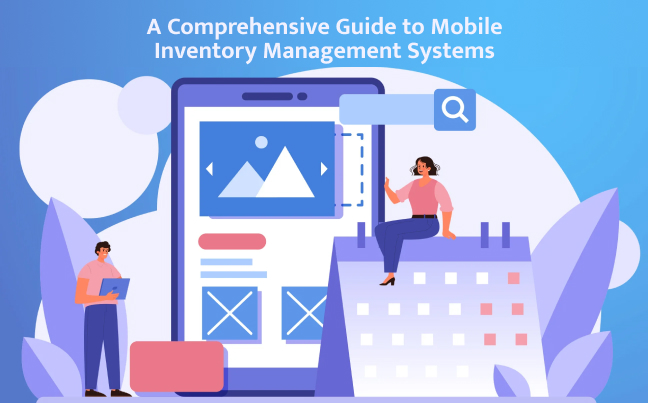A Comprehensive Guide to Mobile Inventory Management Systems

Introduction
In the present business environment, proficient inventory management is significant for guaranteeing smooth tasks and augmenting consumer loyalty. In any case, traditional techniques for inventory management frequently miss the mark, prompting imperfections and mistakes that can disturb the supply network.
To address these difficulties, organizations are going to current arrangements like mobile inventory management systems. These frameworks influence innovation to smooth out the inventory management process, permitting organizations to follow their stock progressively and go with informed choices.
In this complete guide, we will investigate all that you want to be familiar with versatile inventory management frameworks, from key elements to the advancement process. Whether you’re an independent company hoping to further develop your inventory management or a huge undertaking trying to upgrade your tasks, this guide will give important experiences to assist you with pursuing informed choices and accomplishing your business objectives.
Mobile Device Inventory Management: What Is It?
Mobile inventory management refers to the use of mobile devices and software to process inventories. Workers equipped with barcode scanners, cellphones, or tablets track stock movements and update the system of record from the point of work.
Unlike handwritten or typed information, data is taken quickly and accurately with no effort.
The ability to process inventory from anywhere is powerful. Equally significant is the capacity to manage materials from many locations—anywhere in the world—without disruptions or data loss.
More modern technology, such as mobile barcoding, simplifies and accelerates daily operations by enabling automated inventory management workflows ranging from raw material consumption to cycle counting to picking products for order fulfillment.
Another significant advantage is the ability to integrate with enterprise business systems without complicating your technical environment. Intelligent data sharing with ERP platforms, Industry 4.0 devices, RFID, and industrial computers offers complete transparency.
Compared to manual handling, mobile inventory management provides superior performance at a reduced cost, allowing your operations to meet essential warehouse KPIs.
How Do Organizations Profit from Mobile Inventory Management Framework?
Organizations benefit from mobile inventory management frameworks in more than one way:
Constant Inventory Tracking
Mobile inventory management frameworks permit organizations to follow their inventory continuously, giving modern data on stock levels, areas, and developments. This empowers organizations to settle on informed choices and answer rapidly to changes sought after or supply.
Improved Accuracy
Via robotizing the inventory management process, mobile frameworks diminish the gamble of human mistakes related to manual information passage and following. This prompts more noteworthy exactness in inventory counts and decreases the probability of stockouts or overload circumstances.
Expanded Proficiency
Mobile inventory management frameworks smooth out work processes by dispensing with manual errands, for example, paper-based record-keeping and manual stocktaking. This saves workers the opportunity to zero in on more worth-added exercises, working on generally functional productivity.
Upgraded Efficiency
With mobile inventory management systems, delegates can get to inventory data from any spot, while, using mobile contraptions, for instance, cells or tablets. This adaptability takes into consideration quicker independent direction and better cooperation among colleagues, prompting expanded efficiency.
Cost Savings
By lessening mistakes, smoothing out processes, and further developing effectiveness, mobile inventory management frameworks assist organizations with setting aside cash over the long haul. Fewer stockouts and overloads mean lower conveying costs, while further developed exactness decreases the requirement for expensive stock reviews and descriptions.
Key Features of Mobile Inventory Management Systems
Key elements of mobile inventory management frameworks include:
- Real-time inventory following: Permits clients to follow inventory levels, areas, and developments continuously utilizing mobile gadgets.
- Barcode examining: Empowers clients to rapidly and precisely check scanner tags or QR codes to recognize and refresh inventory things.
- Inventory visibility: Gives users complete perceivability into their inventory, including thing details, amounts close by, and stock levels at various areas.
- Multi-area support: Permits organizations with numerous warehouses or capacity areas to oversee inventory across all areas from a solitary mobile application.
- Order management: Empowers clients to make, alter, and satisfy orders straightforwardly from the mobile application, smoothing out the request satisfaction process.
- Alerts and notifications: Sends computerized cautions and warnings to clients for low stock levels, stockouts, or other inventory-related issues.
- Reporting and analysis: Furnish clients with adjustable reports and investigation to follow inventory execution, recognize patterns, and pursue information-driven choices.
- Integration capacities: Incorporates flawlessly with other business frameworks like ERP, CRM, and bookkeeping programming to synchronize inventory information and smooth out
business processes. - User grants and access control: Permits organizations to characterize client jobs and authorizations to control admittance to delicate inventory information and guarantee information security.
- offline functionality: Offers disconnected admittance to inventory information, permitting clients to keep working in any event, when they are not associated with the web.
Steps to Create a Mobile Inventory Management Application
Building a mobile inventory management application includes a few moves toward guaranteeing its usefulness, ease of use, and viability. Here are the critical stages to consider:
- Characterize requirements: Start with social event necessities from partners to comprehend the business needs, objectives, and client assumptions for the inventory management application.
- Lead statistical research: Exploration of existing mobile inventory management applications in the market to distinguish key highlights, functionalities, and patterns. This will help in planning a cutthroat and creative arrangement.
- Plan (UI) and (UX): Make wireframes and mockups to imagine the format, route, and communications of the mobile application. Center around planning an instinctive and easy-to-understand interface that improves convenience and efficiency.
- Pick a development approach: Select the suitable improvement approach given variables like spending plan, timetable, target stages (iOS, Android, or cross-stage), and specialized mastery. Choices incorporate local turn of events, cross-stage advancement systems (e.g., Respond Local, Vacillate), or low-code/no-code stages.
- Create backend infrastructure: Set up the backend framework, including data sets, servers, and APIs, to help the mobile inventory management application. Guarantee versatility, security, and dependability of the backend design to deal with information capacity, recovery, and synchronization.
- Carry out center highlights: Foster the center elements of the mobile inventory management application, for example, inventory following, scanner tag checking, request management, announcing, and client confirmation. Center around executing usefulness that lines up with the characterized prerequisites and client needs.
- Test and debug: Direct intensive testing of the application to distinguish and fix any bugs, mistakes, or ease of use issues. Carry out practical testing, coordination testing, execution testing, and client acknowledgment testing to guarantee the application satisfies quality guidelines and performs dependably across various gadgets and stages.
- Deploy and launch: Send the mobile inventory management application to the application stores (e.g., Apple Application Store, Google Play Store) or venture dissemination channels. Coordinate the send-off with showcasing endeavors to produce mindfulness and drive client reception.
- Assemble feedback and recite: Gather input from clients and partners to distinguish regions for development and future upgrades. Repeat the application in light of client criticism, arising patterns, and changing business prerequisites to upgrade its worth and significance consistently.
- Offer continuous support and upkeep: Offer continuous help and support administrations to resolve any issues, updates, or upgrades required post-send-off. Consistently update the application with new elements, bug fixes, security patches, and execution upgrades to guarantee ideal usefulness and client fulfillment.
Bottom Line
All in all, a mobile inventory management system is an important device for organizations hoping to smooth out their inventory tasks, further develop exactness, and improve efficiency. By utilizing the critical elements and advantages of mobile inventory management systems, organizations can successfully deal with their inventory, track resources progressively, decrease manual blunders, and work on by and large effectiveness.
As organizations keep on taking on computerized answers to improve their tasks, the interest in mobile inventory management systems is supposed to rise. This presents a critical chance for Android application development companies in India to take care of the developing requirements of organizations looking for effective inventory management arrangements.
At Tuvoc Technologies, we work in creating custom mobile inventory management systems custom-fitted to meet the one-of-a-kind prerequisites of organizations across different ventures. Reach us today to hire mobile app developers to go deeper into our mobile application improvement management and how we can assist you with changing your inventory management processes with a custom mobile inventory management system.






